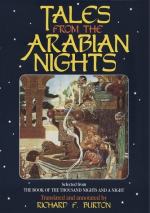[FN#62] The Persians have a Plinian monster called “Tasmeh-pa"=Strap-legs without bones. The “Old Man” is not an ourang-outang nor an Ifrit as in Sayf al-Muluk, Night dcclxxi., but a jocose exaggeration of a custom prevailing in parts of Asia and especially in the African interior where the Tsetse-fly prevents the breeding of burden-beasts. Ibn Batutah tells us that in Malabar everything was borne upon men’s backs. In Central Africa the kinglet rides a slave, and on ceremonious occasions mounts his Prime Minister. I have often been reduced to this style of conveyance and found man the worst imaginable riding: there is no hold and the sharpness of the shoulder-ridge soon makes the legs ache intolerably. The classicists of course find the Shaykh of the Sea in the Tritons and Nereus, and Bochart (Hiero. ii. 858, 880) notices the homo aquaticus, Senex Judaeus and Senex Marinus. Hole (p. 151) suggests the inevitable ouran-outan (man o’ wood), one of “our humiliating copyists,” and quotes “Destiny” in Scarron’s comical romance (Part ii. chapt. i) and “Jealousy” enfolding Rinaldo. (O.F. lib. 42).
[FN#63] More literally “The Chief of the Sea (-Coast),” Shaykh being here a chief rather than an elder (eoldermann, alderman). So the “Old Man of the Mountain,” famous in crusading days, was the Chief who lived on the Nusayriyah or Ansari range, a northern prolongation of the Libanus. Our “old man” of the text may have been suggested by the Koranic commentators on chapt. vi. When an Infidel rises from the grave, a hideous figure meets him and says, “Why wonderest thou at my loathsomeness? I am thine Evil Deeds: thou didst ride upon me in the world and now I will ride upon thee.” (Suiting the action to the words.)
[FN#64] In parts of West Africa and especially in Gorilla-land there are many stories of women and children being carried off by apes, and all believe that the former bear issue to them. It is certain that the anthropoid ape is lustfully excited by the presence of women and I have related how at Cairo (1856) a huge cynocephalus would have raped a girl had it not been bayonetted. Young ladies who visited the Demidoff Gardens and menagerie at Florence were often scandalised by the vicious exposure of the baboons’ parti-coloured persons. The female monkey equally solicits the attentions of man and I heard in India from my late friend, Mirza Ali Akbar of Bombay, that to his knowledge connection had taken place. Whether there would be issue and whether such issue would be viable are still disputed points: the produce would add another difficulty to the pseudo-science called psychology, as such mule would have only half a soul and issue by a congener would have a quarter-soul. A traveller well known to me once proposed to breed pithecoid men who might be useful as hewers of wood and drawers of water: his idea was to put the highest races of apes to the lowest of humanity. I never heard what became of his “breeding stables.”




